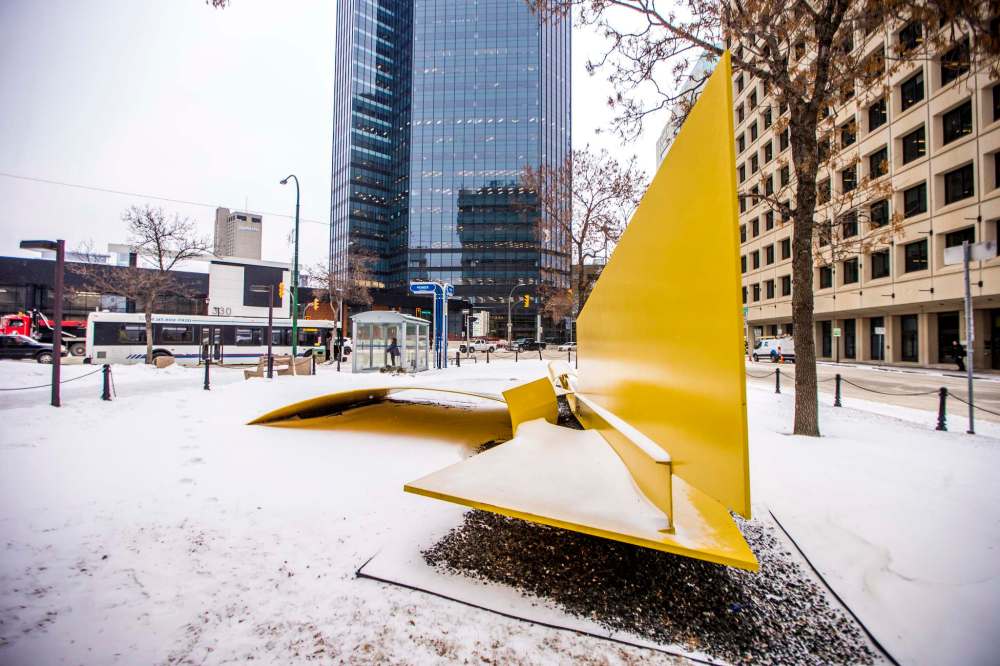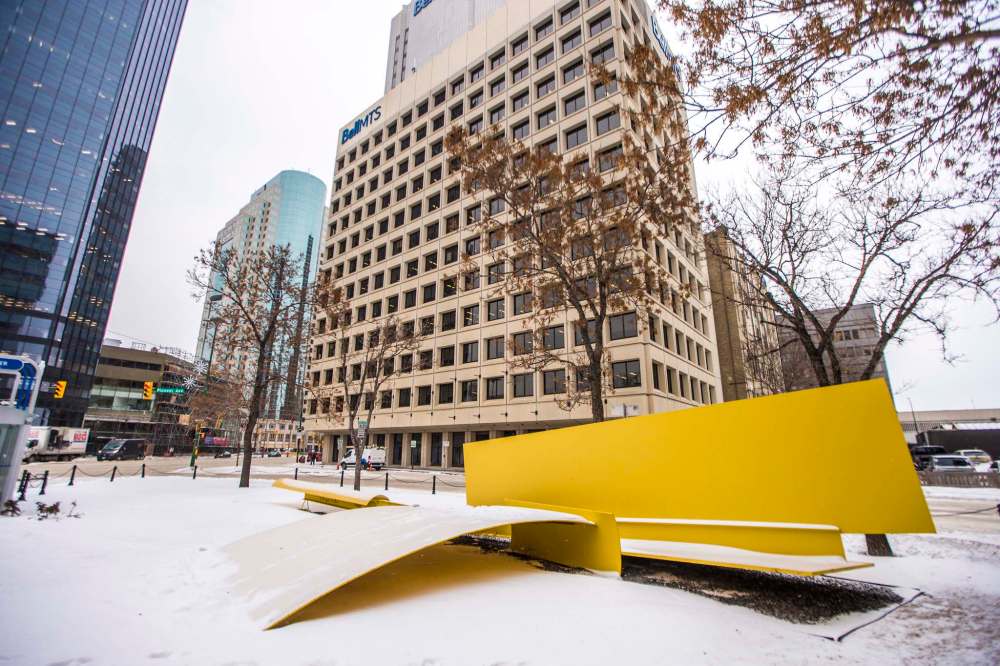Art at the heart
Sculptures at Portage and Main worthy of admiration
Advertisement
Read this article for free:
or
Already have an account? Log in here »
To continue reading, please subscribe:
Monthly Digital Subscription
$0 for the first 4 weeks*
- Enjoy unlimited reading on winnipegfreepress.com
- Read the E-Edition, our digital replica newspaper
- Access News Break, our award-winning app
- Play interactive puzzles
*No charge for 4 weeks then price increases to the regular rate of $19.00 plus GST every four weeks. Offer available to new and qualified returning subscribers only. Cancel any time.
Monthly Digital Subscription
$4.75/week*
- Enjoy unlimited reading on winnipegfreepress.com
- Read the E-Edition, our digital replica newspaper
- Access News Break, our award-winning app
- Play interactive puzzles
*Billed as $19 plus GST every four weeks. Cancel any time.
To continue reading, please subscribe:
Add Free Press access to your Brandon Sun subscription for only an additional
$1 for the first 4 weeks*
*Your next subscription payment will increase by $1.00 and you will be charged $16.99 plus GST for four weeks. After four weeks, your payment will increase to $23.99 plus GST every four weeks.
Read unlimited articles for free today:
or
Already have an account? Log in here »
Hey there, time traveller!
This article was published 18/01/2020 (2145 days ago), so information in it may no longer be current.
Over the years, the plazas of Portage and Main have acquired an interesting and eclectic sculpture collection. The works were installed at different times over the last century, at the invitation of the businesses overlooking our most famous city intersection. They were created by diverse artists reflecting diverse styles and subjects. Here’s a toast to them all to ring in the new year.
First are the gigantic, surreal seated figures of a man and dog, on the west side of the Richardson Building — the city’s first highrise. The green-weathered bronze man and dog overlook Main Street, facing south.
They are haunting and haunted-looking presences, with their eerily empty faces and eyes. The man carries a digitized backpack of some sort on his back, his face is technologized beyond human recognition, and his feet are encased in enormous boots. The sculpture is called North Watch, and was created by renowned Winnipeg artist Ivan Eyre. It was unveiled by Richardson & Sons Ltd. in 2010.

The man and dog are facing south, so that makes them watchers over the north, rather than watchers of it. I’ve always been a little frightened of this installation, as surely the artist intended us to be. Its menace serves as both offence and defence, a mighty howl, with regard to the vast treasures of our thinly defended northern territories, perhaps. Just to get by them without shivering, I’ve given them nicknames — Nick and Narby — and whisper them under my breath when I drive or walk by.
Contrast that with the lofty and dignified cenotaph in front of the Bank of Montreal across the street, overlooking both Main Street and Portage Avenue to the west. The cenotaph was erected by the bank in 1923 to commemorate the bravery and sacrifice of the many Canadian soldiers serving in the First World War. More than a thousand of them were Bank of Montreal employees. Far too many lost their lives in that war, and it seems appropriate to commemorate them in this prominent way.
The bronze cenotaph features a fully dressed soldier, standing at attention on top of a garlanded stone column. His honourable demeanour complements the dignity of the bank’s facade, with its venerable corinthian columns. The realist style employed by the sculptor is still in fashion now, as the prevailing mode for recognizing public figures, in our city at least.
The sculpture was designed and created by American artist James Earl Fraser, after a public competition for the commission. Interestingly, Fraser chose not to depict a generic unknown soldier as was fashionable for war memorials at the time, but rather, to model his after a real person: a man named Wynn Bagnall of Montreal, who served in the Canadian Expeditionary Force and was awarded the Military Cross for his bravery. He died in 1931 and was buried with military honours.
The cenotaph replaced the one originally planned for this site, a bronze bust on a stone plinth of the famous Saulteaux leader Chief Peguis, who signed a peace treaty in 1817 with the Selkirk Settlers. Then the war intervened, and the cenotaph was considered more immediate and important. The Chief Peguis statue, then in planning by the Lord Selkirk Association of Rupert’s Land, who hired Winnipeg sculptor Marguerite Judd Taylor, was relocated to Kildonan Park, where it still stands today, surrounded by pines. (We had women sculptors of public monuments in Winnipeg then? Cool.)
I wish Chief Peguis could have stayed at Portage and Main beside the cenotaph, as a founding father as he was of our multicultural city given his alliance between Indigenous and immigrant settler peoples. Perhaps he is happier in the more tranquil park slightly to the north, with its whimsical bridges and fairy tale huts and lamps, gardens, winding river and Rainbow Stage.
Between North Watch and the cenotaph, we see Leo Mol’s whimsical Tree Children, which arrived on the Richardson plaza in 2002. The sculpture is not smooth and sophisticated in the elevated realist signature style of Mol. Rather, it bears the marks of rough daubing, as if barely emerged out of clay. The children, too, perched on their trimmed tree trunk, look rough and tumble, barely human, ready for adventure or a fight, or a fall.
My favourite sculpture on the plaza is Peter Sawatzky’s monumental Seal River Crossing, unveiled in 2007, in honour of the 150th anniversary of James Richardson & Sons, a company founded 10 years before Canada’s confederation. That’s a lot of generosity, devotion, hard work and skill we can all join in celebrating. Sawatzky has made a name for himself in recent years with his exquisite hyper-realist bronze imitations of animals in their natural habitats, magically transporting the spirit of the wild into our urban environments.
If you’ve never stood in front of this extraordinary work of art, do it soon. The sculpture features an impressive 29 feet of bronze caribou crossing the turbulent waters of the Seal River of northern Manitoba. I could stand here for hours, feeling the power of those gorgeous curved caribou horns, and the turbulence of the rushing water, vibrating through the bronze. The caribou crowd together in the water, for ballast and encouragement. None will be left behind.
One very short block south of the plaza, directly in front of the Canadian Grain Commission building, we can see No. 1 Northern, a bright yellow stylized metal sculpture by Saskatchewan artist John Cullen Nugent, denoting the flat Prairie landscape, the cheery yellow sun and wheat and sunflower fields we all love to drive through on bright blue-sky summer afternoons. It is named for the foremost kind of wheat grown on the Prairies. The installation is created in the industrial abstract expressionist mode made fashionable in the 1960s.

If you’ve been confused by the appearance, disappearance and reappearance of this eye-catching installation over the past several decades, you’re not alone.
The sculpture sparked outrage after its original installation in front of the Grain Commission in 1976, and was removed two years later, cut up in three pieces and put into storage. A few years after that, the work reappeared in front of the Revenue Canada building on Stapon Road. People complained about it there too, and it was dismantled again in 1993 and sent to a scrapyard “salvage area.”
Nugent heard about this in 1997 and pleaded for the public’s help in finding the piece and reinstalling it in a prominent public Winnipeg location, as per its original commission. Later that same year it reappeared back in its first location, in front of the Grain Commission building, where it has flourished ever since.
Since the emergence of the Winnipeg Arts Council’s contemporary public art program, curated by the talented Trish Wasney all over the city and featuring a wide range of contemporary expressions and styles by numerous Winnipeg artists, No. 1 Northern no longer seems risqué. I personally think it’s gorgeous, and am happy to see it there on Main Street every time I drive by. It brightens up the grey streets, and provides a nice horizontal homage to our Prairie landscape and agricultural heritage among all those tall vertical buildings.
Di Brandt served as the City of Winnipeg’s inaugural poet laureate (2018-2019).
di.brandt@shaw.ca
History
Updated on Saturday, January 18, 2020 8:06 PM CST: Correction made: James Earl Fraser was awarded the Military Cross, not the Victoria Cross.

